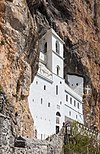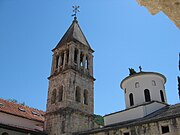Church of the Holy Annunciation, Dubrovnik
| Holy Annunciation Orthodox church | |
|---|---|
| Crkva sv. Blagovještenja Црква св. Благовјештења | |
 Holy Annunciation Orthodox church | |
 | |
| Location | Dubrovnik |
| Country | Croatia |
| Denomination | Serbian Orthodox |
| History | |
| Dedication | Annunciation |
| Architecture | |
| Style | Neo-Byzantine[1] |
| Years built | 1877[2] |
| Administration | |
| Archdiocese | Eparchy of Zahumlje and Herzegovina |
The Church of the Holy Annunciation (Croatian: Crkva svetih Blagovijesti; Serbian: Crkva Svetog blagovještenja / Црква Светог благовјештења) is a Serbian Orthodox church in Dubrovnik, south Croatia. It was built in 1877.
History[]
On April 30, 1867, in the Municipal Assembly, rich trader bought three houses of baron Frano Gondola with a garden behind them for a sum of 28,500 fiorins inside the Walls of Dubrovnik in the old town.[3]
The church has a valuable collection of icons, some of them dating from the 15th and 16th centuries.[4][5] A comprehensive history of the church and its parish entitled The Serbian Orthodox Church in Dubrovnik to the Twentieth Century was published in Dubrovnik, Belgrade and in Trebinje in 2007.[6][7] The book was published in the Gaj's Latin and the Serbian Cyrillic alphabet[8]
Damage and reconstruction[]
The church sustained damage from bombing during the Siege of Dubrovnik.[2]
In 2009, the church was restored using funds from the Ministry of Culture of Croatia, City of Dubrovnik, Dubrovnik-Neretva County, private contributions and credit. This was the first restoration of the church.[2]
Museum of Serbian Orthodox Church in Dubrovnik[]
The church community maintains a museum of the Serbian Orthodox Church in Dubrovnik. It keeps religious objects such as a copy of the Miroslav Gospels from 1897, a gospel in Russian printed in Moscow in 1805 and busts of Ivan Gundulić and Vuk Stefanović Karadžić[4] The museum also has 18 portraits. Of these, 9 depict Vlaho Bukovac[4] Other portraits depict Medo Pucić, Valtazar Bogišić, Petar II Petrović-Njegoš and Vuk Stefanović Karadžić.[4] A number of old gospels, big collection of icons, highly decorated priest robes, chalices and jewellery is also kept as a part of the Museum collection.[9]
Library of Serbian Orthodox Church in Dubrovnik[]
The church owns a library of about 12 000 books. In addition to liturgical books in Church Slavonic language, there are also books on different themes in Italian, French, Russian and other languages. Of note are a New Testament printed in Kiev in 1703 and a Menologium printed in Kiev in 1757 [4]
See also[]
- Serbs of Dubrovnik
- Walls of Dubrovnik
- Dubrovnik Synagogue
- Dubrovnik Cathedral
- St. Saviour Church, Dubrovnik
- Eparchy of Zahumlje and Herzegovina
- List of Serbian Orthodox churches in Croatia
References[]
| Wikimedia Commons has media related to Holy Annunciation Orthodox church (Dubrovnik). |
- ^ [1][permanent dead link] Hart.
- ^ a b c [2] "Ministarstvo kulture Republike Hrvatske – Iz tiska – Ministarstvo kulture u tisku – Obnova Pravoslavne crkve u Dubrovniku" Ministry of Culture. Accessed 14 February 2012.
- ^ Spasić, Goran; Reljić, Jelica; Perišić, Miroslav (2012). Kultura Srba u Dubrovniku 1790-2010 iz riznice Srpske pravoslavne crkve Svetog blagoveštenja. Beograd: Arhiv Srbije.
- ^ a b c d e [3] "Kultura : Obnovljena pravoslavna crkva u Dubrovniku: Politika." Politika.rs Accessed 14 February 2012.
- ^ [4] MDC Crkvene zbirke. Hvm.mdc.hr. Accessed 14 February 2012.
- ^ [5] "Hrvatska akademija znanosti i umjetnosti. Knjižnica" Katalog.hazu.h 15 July 2011. 14 February 2012
- ^ [6] "Mikro knjiga: Prikaz: Srpska pravoslavna crkva u Dubrovniku do početka 20. veka (tvrdi povez), ilustrovana." Mikroknjiga.rs Accessed 14 February 2012
- ^ [7] "Nepoznati pravoslavni Dubrovnik" Mail-archive.com. 2 December 2012. Accessed 14 February 2012.
- ^ Spasić, Goran; Reljić, Jelica; Perišić, Miroslav (2012). Kultura Srba u Dubrovniku 1790-2010 iz riznice Srpske pravoslavne crkve Svetog blagoveštenja. Beograd: Arhiv Srbije.
- Buildings and structures in Dubrovnik
- Serbian Orthodox church buildings in Croatia
- Churches completed in 1877
- 19th-century Serbian Orthodox church buildings
- Byzantine Revival architecture
- Tourist attractions in Dubrovnik-Neretva County
- 1877 establishments in Austria-Hungary

